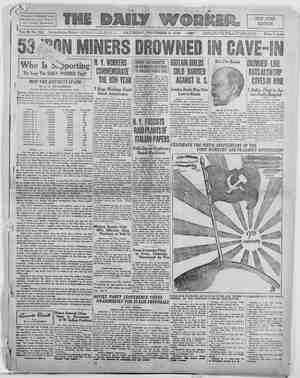The Daily Worker Newspaper, November 6, 1926, Page 7
You have reached the hourly page view limit. Unlock higher limit to our entire archive!
Subscribers enjoy higher page view limit, downloads, and exclusive features.
| ; f Suplimet c+ THE DAILY WORKER. ‘ ee et ¢ | i ALEX. BITTELMAN, Editor. Second Section: This Magazine Section Appears Every Saturday In The DAILY WORKER. SATURDAY, NOVEMBER 6, 1926 c aio N. Bucharin & Ellsarova { celebrate the Ninth Year of f the Russian Revolution. Nine years of titanic effort by millions of workers and peasants to with stand capitalist aggression. Nine years of creative mass activity te build. a new order of society. Nine years of world history of which every inch of space and second of time breathes hope and inspiration to the oppressed and exploited the world over. Socialism as a step to Comma nism is taking concrete shape and form in the Soviet Union. The ideal of ages is becoming a reality before our very eyes. We are im { measurably proud of the gigantie achievements of our brothers in the great workers’ republic. We are with them. We are for them. And we will continue unceasingly te work for the great day when the workers and poor farmers of the United States will realize their hip toric task and power and will starg out on the great march of struggle which leads to victory, freedom and happiness. ease". ; Demand the Recognition of The Ninth Year ' } There was darkness: now there are Comsomniols. There was silence: now there is song. . ere were priests: now there is Science. There were Cossacks: now there are teachers. LENIN! LENIN! LENIN! Men beat their wives: now all are comrades. Men drank vodka: now they read books. Men died in famine: now there are tractors. Men feared the Czar: now are unions. LENIN! LENIN! LENINI ° Now there is but wait, ; is st ‘wall Cae pens the So xtiat LENIN! LENIN! LENIN] ' LENIN! J. Stalin. HAT is the power that stands like a Tock behind the Union of Socialist Soviet Re publics? It is the Communist Party of the Soviet Um fon. Lenin’s party. The party of several million adult and young work- ers and peasants. J Stalin fs fts general secretary. N. Bucharia is the chief editor of its central organ, the “Pravda.” These te gether with M. Tomsky, head of the Russian trade unions, A. Rykof& chairman of the Cour cil of People’s Commis ears, N. Kalinin, presi Gent of the Soviet Um fon, and Voroshilov, head of the Red Army, constitute the leading committees of Lenin's



